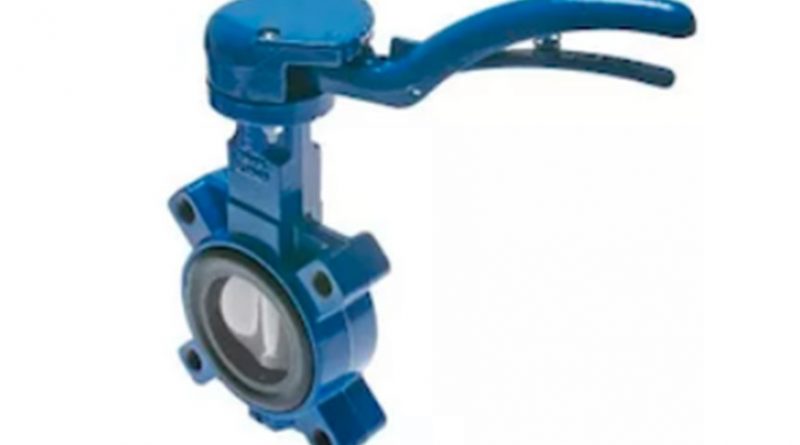What Is a Butterfly Valve?
Butterfly valves belong to a group of quarter-turn valves used to control fluid media flow. They work similarly to ball valves, except that the two differ in their operational efficiency and performance. A butterfly valve features a disc connected to a rod, where the rotation of the rod controls the opening and closing of the valve.
Due to their lightweight, lower costs, small installation footprint, and larger size design, butterfly valves find several applications across industries. They can be operated manually using handles and gears or by automatic actuators. We’ve covered more below.
How Butterfly Valves Work
Butterfly valves feature a housing or body, seal, stem, and disc with relatively simple construction. The disc sits perpendicular to the flow direction in a closed position, sealed by the valve seat. The disc is often located at the center of the stem and the connected pipe, while an o-ring seals the stem connected to a handle or actuator.

Figure 2: Actuator/handle (A), Stem (B), Stem O-ring (C), Seal (D), Disc (E), Valve body (F).
When the handle or actuator rotates the stem by 90 degrees, the disc moves away from the valve seat, positioning itself parallel to the flow. Rotating the stem partially allows the flow to be proportional or throttled.
If butterfly valves are used for modulating services, they are either linear or have an equal percentage characteristic. The latter means that equal increments of valve travel produce a proportional percentage change in the flow rate.
In other words, there’s a logarithmic relationship between the flow rate and the disc travel. The flow rate is directly proportional to the disc travel distance with the linear design. For instance, if the disc is opened 1/8 of a turn (i.e., 11.25 degrees), then the valve’s flow rate is 12.5%.
Butterfly Valves Types
Butterfly valves can be categorized into several types based on the disc closure design, actuation method, and connection design. Below is a quick overview.
Disc Closure Design
Under this category are two valve types: eccentric and concentric. This classification depends on the location of the stem with respect to the disc and the seat angle on which the disc closes.
With the concentric type, the seat is located inside the diameter of the valve body, and the stem goes through the disc’s centerline. This is a zero-offset valve design where the seat rubber’s flexibility determines the seal’s efficiency when the valve is closed. These valves are often used for low-pressure applications.
On the other hand, the stem of an eccentric butterfly valve doesn’t pass through the disc centerline rather behind it. Eccentric valve types can be classified into single-offset, double-offset, and triple-offset valves. These three are designed to reduce the disc contact with the seal until the valve is fully closed. The goal is to improve the valve’s service life.
The triple offset type is the more efficient of the three and is used in critical applications. Generally, eccentric valves have a higher-pressure rating and are less susceptible to wear.
Connection Design
A butterfly valve can be connected to the piping system in various ways. There are three common valve types based on the connection design. These are lug type, wafer type, and flange connection. The wafer style is the most economical, plus it’s designed to ensure efficient sealing against bi-directional pressure difference and backflows.
The lug style has some threaded inserts outside the valve body. This allows for disconnecting one side for dead-end service. Such valves are generally designed for low-pressure applications, plus they carry the weight of the pipe through the valve body.
Actuation Method
As stated earlier, butterfly valves can be operated by handles, gears, or automatic actuators. Manual actuated valves are cheap and easy to use. Smaller butterfly valves feature a hand lever, while a gear system can actuate the slightly larger ones. These valves are self-locking, meaning they cannot be back-driven but can be equipped with position indicators for efficient operation.
Power-operated actuators are often used when controlling butterfly valves used in highly sensitive and demanding applications. These actuators can be classified into three:
- Electric actuators – use an electric motor to close and open the valve stem.
- Hydraulic actuators – use hydraulic pressure to move a diaphragm or piston to close and open the valve.
- Pneumatic actuators – use compressed air to move a diaphragm or piston to close and open the valve.
Summary
Butterfly valves are some of the widely used valves in the market, thanks to their versatile design, cost-efficiency, and ease of operation. Except in high-pressure applications and where the flow capacity must be maintained at some value, butterfly valves can almost always replace ball valves.
Some industries where butterfly valves find their application include pharma, food, water supply, chemical, and fuel handling operations. Their larger sizes also make them ideal for handling slurries and other low-pressure liquids with relatively large amounts of solids.
When choosing a butterfly valve, always pay attention to your specific needs and unique applications. And where possible, seek professional guidance when navigating the market to avoid selection mistakes.

